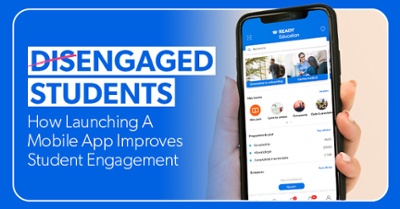A Better Communication Strategy To Improve Student Success In Higher Ed
By: Ready Education on 28-Feb-2023 03:00:00A Better Communication Strategy To Improve Student Success In Higher Ed
By: Ready Education on 28-Feb-2023 03:00:00
It can be hard for institutions to develop a modern communication strategy that meets their goals. As a matter of fact:
- Many institutions use several communication tools. Mails, virtual workplace, learning management system (Moodle…), website, social media, etc. The information is spread out on so many different platforms that students don’t know how and where to find it. As a consequence, they can be a bit lost and are often misinformed, or not informed at all;
- Students don’t read emails. Not the right tone, too long, too much (sometimes unnecessary) information, unattractive format… Most emails end up in the trash. In the US, research has shown that 54% of all emails remain unopened and 39% of emails are ignored resulting in 77% of students feeling disconnected and therefore unengaged. In Europe, one of Ready Education’s mobile solutions shows a 90.5% open rate for push notifications sent in 2022, compared to the 30% open rate of emails.
- Last but not least, institutions rarely have a dedicated team in charge of setting up a well-thought communication strategy. Most of the time, there’s one person with no tools, no roadmap and no resources to build up a communication plan. Hence students are left with poor information.
Does any of that sound familiar? If the answer is yes, read our article and find some tips to implement an efficient communication strategy and improve student experience.
Focus On Mobile
Here is our number 1 advice: build your communication strategy around mobile. Indeed, it is the favourite tool of young generations, students included. 98% of people from 18 to 25 years old have a smartphone and check it several times a day.1 Also, the time spent on mobile devices has increased by 18% for Gen Y (people born between 1980 and 1997) and by 19% for Gen Z (1998-2010) during the global pandemic.
Therefore, using mobile technologies to communicate with your students seems to be the best move. It will help you:
- Gather all the information, resources and services your students need in one same place;
- Send personalised and targeted messages to your students who will receive notifications.
Want to know more about how an app can help you improve student engagement?

Get Students' Attention With Customisation
The hardest part of dealing with highly connected students is to get their attention and fit into the flow of communication they receive every day. This is why targeted and customised messages come in handy. It’s a great way to reach the students with the information they need, without overburdening them.
With a mobile app messaging feature, you can for instance:
- Create tailored-made content: you can write your own messages. Go straight to the point, use key words and relevant catchphrases to make sure students read them;
- Target your audiences: you can also build user personas. New students, Master students, scholarship students… Send the right messages at the right time, to the right people.
Stand Out From The Crowd With Creativity
Personalising your communication is great. Doing it with a little bit of creativity is even better! It increases your chances of being read.
Here are a few more tips to be creative:
- Play on the form: you can also communicate with visuals. Send GIFs, videos or images to strengthen your messages;
- Use different formats: with a mobile app, you can choose push notifications but also multiple-choice or open questions MCQ, posts on a community or social media feed… There are many options to interact with your students and encourage participative communication.
Build an Editorial Board to Implement Your Strategy
Once you have laid out the foundations of your communication strategy - a centralised and relevant communication meeting students’ needs - it’s time to implement it.
Our recommendation would be to build an editorial board in charge of executing your strategy:
- Who: anyone as long as they are invested in your project. Ideally, board members and people from the communication department should be involved to make sure there’s no gap between theory and practice;
- What roles: make sure every member has a specific role and clear assignments. For example: someone in charge of writing the messages, another one in charge of publishing them, etc.
- Best practices: to manage the board, you can have a weekly or bi-monthly meeting, implement a voting system to make decisions when there are disagreements, or put in place some simple rules (e.g., the person in charge of publishing messages should also proofread them and correct them if needed).
Are you ready to implement a modern communication strategy to draw your students’ attention and improve their experience? Contact us for more information on our mobile services.
1According to a study conducted by Ready Education, HEADway Advisory and EdTech France

.png)
.png)
.png)

